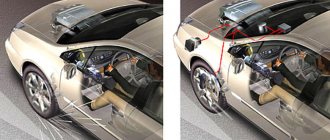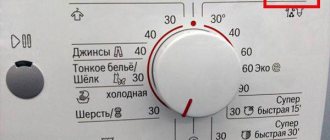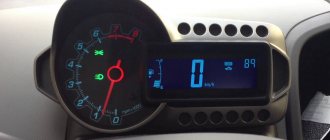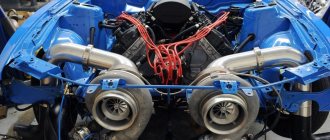The appearance of the first parking sensors was greeted with open skepticism by most drivers. In those days, the ability to place your car in a row of similar ones was taken for granted, and the ability to feel the dimensions of a car was a vital necessity. But over time, the number of cars began to increase rapidly, which affected the density of city parking. As a result, today even professionals risk being unable to park their car on an ordinary city street, where, as a rule, cars are parked haphazardly.
In these conditions, the presence of assistants, especially intellectual ones, no longer looks like an excess. Moreover, most experts are convinced that such parking management systems are the future.
What is ISP
While passive parking assistants appeared on cars quite a long time ago, the intelligent driver assistance system for parking began to be actively implemented only in the 21st century, and at first it was the privilege of only elite car models.
But gradually, with the development of the microelement and software base, these systems began to be developed and implemented by many automakers. Being another component of many different electronic devices that make driving a vehicle easier, such a system allows parking in semi-automatic (automated) / automatic mode. The latter type essentially does not require human intervention.
Modern parking systems are designed for various parking schemes. The most common are perpendicular (transverse) and parallel parking, while the parallel scheme is much more difficult to implement, but it is the one that allows you to optimize the road space in the best possible way. It is not surprising that most active systems are designed for parallel parking.
The functionality of such parking systems can vary significantly, but what they have in common is the ability to turn off and perform such maneuvers only in manual mode.
To be fair, we note that those drivers who are already accustomed to using the services of many sensors turn off parking systems only in cases where they are absolutely sure that it is safe to park the car (in the absence of cars).
But this happens in a modern metropolis only in the dead of night.
What is intelligent SAP?
This is a set of devices whose function is aimed at helping the driver when parking. During the maneuver, a group of control and executive operations is implemented, partly coordinating and correcting actions during parallel or perpendicular parking.
In particular, this type of intelligent automatic parking system monitors the vehicle speed and steering angle in a coordinated manner. Sensors located in the bumper area provide significant assistance in obtaining information about the parking process. As a rule, they are represented by ultrasonic detectors that record the distance to the nearest object. If a critical distance is overcome, they give an appropriate signal.
What does an intelligent parking system consist of?
Since accuracy comes first when carrying out parking maneuvers, ideal interaction must be established between the sensors that monitor the position of the vehicle and the surrounding environment and the control unit, and with a very high speed of information exchange.
Typically, a car is equipped with a solid pool of ultrasonic sensors (IPAS), which transmit data to a computer control unit. The latter is engaged in analyzing the information received and developing solutions in the form of commands, which in turn are sent to actuators.
It cannot be said that the sensors used in automatic car parking devices are completely identical to the sensors of passive systems such as parking sensors. For their normal operation, a much greater visibility is required, so their range of action has been increased to 4.5 meters.
It is difficult to talk about their exact number - it differs among different automakers. Let's say, the systems being developed by the Volkswagen automaker have twelve of them, of which four IPAS are used in the rear, another four are mounted in the front, and the rest are mounted on the sides of the car, allowing them to completely cover the surrounding space within a given radius.
Typically, the intelligent parking system is not activated. It starts working only after pressing a button (or lever, depending on the developer), which in most cases is located either on the instrument panel or on the steering wheel.
Recently, an obligatory component of such a kit is an information display, usually located in the center console area. With its help, the driver can personally observe how the parking process occurs and, if necessary, manually make the required adjustments.
Operating principle of intelligent parking systems
After pressing the system activation key, the control unit begins to work, receiving data from sensors and calculating the optimal trajectory of movement, taking into account its current spatial position. After this, the corresponding commands are transmitted to the actuators that are part of the complex called the autopilot.
The operation of the car parking system is impossible without coordination with many other electronic systems (vehicle directional stability, control of the operation of the power unit, automatic transmission, electric power steering, etc.). The main control unit has assistants who are responsible for interacting with other electronic systems.
Schematically, the operation of an automated parking system can be divided into two stages: searching for a free parking space and actually performing the maneuver.
SAP in Kia Optima cars
An expanded version of the electronic parking valet discussed in the previous case, which is distinguished by a wider range of functions. We are talking about the SPAS system, which has a number of fundamental differences from classic parking sensors:
- Wider sensor coverage: range of about 5 m.
- Interaction with almost all active vehicle safety equipment.
- Closer interaction with controls.
The above differences indicate that the automatic car parking system has received more freedom of action and has become less dependent on humans. It is enough to note that during maneuvering SPAS can take control of elements of the brake system, throttle valve, gearbox, engine control unit, exchange rate stability system, power steering, etc.
Finding a parking space
At this stage, the main character is ultrasonic sensors. Consider, for example, the same Park Assist from Volkswagen. When driving slowly along a parking lot (or just along the street where you want to park your car) at a speed not exceeding 40 km/h for a parallel car and no more than 20 km/h - if the cars are parked perpendicular to the sidewalk or at an angle, side sensors record the distance between parked cars, transmitting this data to the control unit. More advanced devices have expanded functionality. They are capable of not only determining the distance, but also the orientation of cars standing at the edge of the road.
Next, the automatic parking system control unit comes into operation. If it determines that there is a gap sufficient to park the car, it gives the driver an audible signal or shows on the display that a free space has been found and the maneuver can begin directly.
Park Assist from Volkswagen
Please note that the parking space algorithm for different systems can vary greatly, so if you are used to one car model, you can get completely unexpected results by switching to another. But this is a matter of habit.
Park Assist, for example, determines the possibility of performing a parking maneuver if it detects that the distance between two adjacent cars in a row is 0.8 meters greater than the length of the donor car.
The parking system installed in Opel cars considers the safe distance to be one meter, and not a centimeter less.
Automatic parking process
Regardless of the manufacturer, all modern intelligent parking systems, after determining a convenient place to park the car, offer the driver to choose one of two options for further actions.
One of them is to offer the driver a precise algorithm of actions that will help him perform the maneuver quickly and without problems. In the second case, all parking actions will be performed without the participation of the driver (but under his direct control).
In the first case, a system of prompts (voice, visual or text) is launched, which helps the driver independently perform the operation, and the proposed algorithm takes into account the actions already performed by the driver, that is, it is calculated in real time, regardless of the make/model of the vehicle.
The prompts themselves indicate to the driver the order in which to perform the necessary actions (which way to turn the steering wheel, when to stop doing this, at what speed to move at the moment, when to slow down, etc.). Agree, even an absolute beginner can cope with such instructions.
However, the second option is more promising - when parking is carried out in a fully automatic mode (the first option is called semi-automatic, less often automated). True, the driver should not completely relax at this time.
The process itself is carried out by activating a cycle of actions controlled by an electronic system that activates the vehicle’s currently required actuators. Such devices are:
- electric power steering,
- throttle valve,
- elements of the HR system (return pump, brake valves),
- automatic transmission valves.
These devices are enough to perform any maneuvers: turning the steering wheel, simulating pressing the accelerator pedal, changing gears and braking.
At any time, the driver has the opportunity to interrupt automatic parking and complete it manually, however, if all of the listed components are in working order, such systems practically do not make mistakes. Moreover, the latest generations of IPS are able to park cars even if the driver is not there - in this case, it is enough to send a corresponding signal from the key.
The intelligence of such systems is not limited to this: having, for example, parked the car in the garage without your presence, they themselves will turn off the engine, turn off the lights in the cabin and even turn on the alarm. If necessary, the parking report can be sent to your mobile device. So we can say with confidence that, despite the passive resistance of experienced drivers, such intelligent systems are the future, given that the average age of drivers is constantly decreasing, and the number of women driving is growing.
Intelligent automatic parking systems in cars. Pros and cons
Stas [stas90]
25.01.2019,
In recent years, the tendency to endow the car with intelligence has intensified. If earlier it concerned only additional systems, such as navigation, multimedia and other bells and whistles, now “intelligence” reaches the holy of holies of every driver - driving. Unmanned vehicles have appeared and are already operating. Over time, they will abandon the classic profession of driver.
I don’t understand what a thrill it would be to buy a personal car in order to constantly spend money on its repairs, and that’s all. With such success, you can use public transport, which by then will also be unmanned. I personally find it stressful to be a passenger when my son is driving it. And he has more brains than a car. Imagine how I can ride as a passenger when the car is controlled by a soulless computer. I am an auto electrician, and I know more than anyone how unreliable all electronics are. But that’s not about that now.
The process is underway, and the first sign of automation of car control is an intelligent automatic parking system. It should not be confused with parking sensors. The latter only monitors the approach to obstacles when parking, informs the driver about them so that he can make a decision himself. There are also automatic multi-storey parking lots, when the driver leaves the car on a special platform, then the system places it in place automatically using elevator equipment.
Some historical facts
Automotive concerns first began developing automated parking systems in the early 2000s. Volkswagen has made the most progress in this direction. As far as I remember, he presented the first experimental version, in my opinion, of the Turan, in 2005-2006. The system was called Park Assist, which is understandable. It had an automatic perpendicular parking mode. If anyone has forgotten what it is, let me remind you:
Perpendicular parking is an easier way. Over time, the system was improved to a parallel parking option:
It took about five years to perfect the automated parking system. In order to keep up with technical solutions, other automakers followed Volkswagen. As usual, without imitating their firstborn, they called their systems differently:
- Volkswagen - Park Assist and Park Assist Vision;
- BMW - Remote Park Assist System;
- Audi - Parking System;
- Toyota and Lexus - Intelligent Parking Assist System;
- KIA - SPAS (Smart Parking Assistant System);
- Ford and Mercedes - Active Park Assist;
- Opel - Advanced Park Assist.
There are some differences in their work. For example, Park Assist VW can squeeze a Volkswagen into parallel parking if the length of the “hole” is 1 meter greater than the length of the car. But Opel’s Advanced Park Assist can do this at a distance of 80 centimeters greater than the length of the car. Not bad at all, especially for the open spaces of Moscow.
More recently, fully autonomous parking systems have begun to appear. This is when the car is driven to the intended parking spot, then the driver gets out of the car, switching to automatic mode. The remote control (or smartphone) remains in his hands. After this, parking is performed in fully automatic mode:
This concept was realized at the presentation of the BMW i3 in Austria just recently.
Operating principle of automatic parking systems
Despite the differences in the operation of all systems from different manufacturers, the technical implementation is almost the same. The difference is only in the circuitry and software design. The system includes:
- a set of sensors, usually ultrasonic type;
- a set of executive modules that transmit signals to control the car;
- centralized control unit;
- communication system for remote monitoring;
- display or other video control device.
The sequence of interaction of the automated parking system:
- At the first stage, the system is turned on using a special button near the instrument panel, on the multifunction steering wheel or the touch panel of the car function control system.
- After activating the automatic parking mode, signals are transmitted to turn on all sensors and actuators, and the control program is loaded.
- At the third stage, the situation around the car is analyzed using ultrasonic sensors. They differ from parking sensors with a higher range of action (5 meters or more). A two-dimensional or three-dimensional model of the road situation is formed in the control unit. The difference between this model and parking sensors is that the image is updated more frequently in case of possible movement of neighboring objects. The system should ideally take into account the sudden appearance of small obstacles. It could be a pet or, God forbid, a child.
- The program simulates a movement program with minimal switching of modes back and forth, left and right.
- Transition to the execution of commands with simultaneous monitoring of the situation. The control unit controls:
- engine;
- braking system;
- power steering;
- automatic transmission;
- lighting equipment and other systems.
Apparently the automatic parking system is very finicky. If at least one node or device in the systems listed above is faulty, automatic parking is impossible. It is almost impossible to find a fully functional car on our roads after five years of operation, so you should not hope that the automated parking system will last long.
The feasibility of purchasing a car with the additional option of automated parking
I turn again to the topic started in my lyrical introduction. I'll weigh the pros and cons.
Behind:
- This system is useful for inexperienced drivers, especially those in high heels. It can save a lot of money on trouble-free parking. These are the types of accidents that are most likely to occur for this category of drivers.
- The system will help in conditions of poor and limited visibility.
- Automated parking is useful if the driver is sick or tired.
Against:
- High cost, including maintenance.
- Short period of correct service.
- Difficulty in repair. Everything in the system is important: the distance between the emitters, the car model, the wheelbase. You cannot install a system from another car model in place of a faulty one.
- Possibility of hitting “invisible” obstacles (open hatches, pets).
- The manufacturer is not responsible for any accidents occurring during automated parking. Ultimately, the decision to implement it is made by the driver.
- Finally, it's just creepy.











